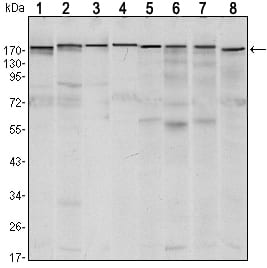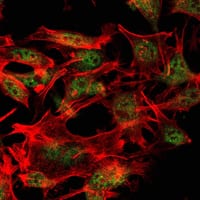

| WB | 1/500 - 1/2000 | Human,Mouse,Monkey |
| IF | 咨询技术 | Human,Mouse,Monkey |
| IHC | 咨询技术 | Human,Mouse,Monkey |
| ICC | 1/200 - 1/1000 | Human,Mouse,Monkey |
| FCM | 咨询技术 | Human,Mouse,Monkey |
| Elisa | 1/10000 | Human,Mouse,Monkey |
| Aliases | ESET; KG1T; KMT1E; KIAA0067; H3-K9-HMTase4; SETDB1 |
| Entrez GeneID | 9869 |
| clone | 5H6A12 |
| WB Predicted band size | 180kDa |
| Host/Isotype | Mouse IgG1 |
| Antibody Type | Primary antibody |
| Storage | Store at 4°C short term. Aliquot and store at -20°C long term. Avoid freeze/thaw cycles. |
| Species Reactivity | Human,Mouse,Monkey |
| Immunogen | Purified recombinant fragment of human SETDB1 expressed in E. Coli. |
| Formulation | Purified antibody in PBS with 0.05% sodium azide. |
+ +
以下是3-4条关于SETDB1抗体的参考文献(简化格式):
1. **文献名称**: "SETDB1: a novel KAP-1-associated histone H3 lysine 9-specific methyltransferase involved in the silencing of retroelements"
**作者**: Schultz DC et al.
**摘要**: 该研究首次鉴定SETDB1为H3K9特异性组蛋白甲基转移酶,与KAP1协同调控逆转录转座子的表观遗传沉默。文中使用SETDB1抗体进行免疫共沉淀(Co-IP)和染色质免疫沉淀(ChIP),验证其与异染色质形成的关联。
2. **文献名称**: "The histone methyltransferase SETDB1 represses endogenous and exogenous retroviruses in embryonic stem cells"
**作者**: Bilodeau S et al.
**摘要**: 研究证明SETDB1通过H3K9三甲基化抑制胚胎干细胞中内源性和外源性逆转录病毒的表达。实验中通过Western blot和免疫荧光使用SETDB1抗体,确认其核定位及在基因沉默中的功能。
3. **文献名称**: "The histone methyltransferase SETDB1 modulates survival of melanoma cells through direct regulation of MYC expression"
**作者**: Cheng D et al.
**摘要**: 该文献揭示SETDB1通过调控致癌基因MYC促进黑色素瘤进展。研究使用特异性SETDB1抗体进行ChIP-seq和免疫组化(IHC),发现其与MYC启动子区域的结合及临床预后的相关性。
4. **文献名称**: "KAP1 controls endogenous retroviruses in embryonic stem cells through histone modifications"
**作者**: Rowe HM et al.
**摘要**: 研究探讨SETDB1与KAP1复合物在抑制胚胎干细胞中逆转录病毒的作用。通过SETDB1抗体的染色质分析,证实其介导的H3K9me3修饰对病毒沉默的调控机制。
这些文献均涉及SETDB1抗体的实验应用(如Western blot、ChIP、免疫荧光等),并聚焦于其在表观遗传调控和疾病中的功能。
**Background of SETDB1 Antibody**
SETDB1 (SET Domain Bifurcated Histone Lysine Methyltransferase 1) is a critical epigenetic regulator that catalyzes the addition of methyl groups to histone H3 at lysine 9 (H3K9me3), a hallmark of transcriptionally repressive heterochromatin. This enzyme plays essential roles in maintaining genome stability, silencing retrotransposons, and regulating gene expression during development and cellular differentiation. Dysregulation of SETDB1 has been implicated in cancers, neurological disorders, and immune dysfunctions, highlighting its importance in both normal physiology and disease.
The SETDB1 antibody is a widely used tool in molecular and cellular biology to detect and quantify SETDB1 protein levels, assess its subcellular localization, and investigate its interactions with chromatin or other regulatory partners. Validated applications include Western blotting, immunoprecipitation (IP), chromatin immunoprecipitation (ChIP), and immunofluorescence (IF). Researchers rely on high-specificity SETDB1 antibodies to study its role in epigenetic silencing mechanisms, tumorigenesis, and developmental pathways.
Recent studies have also explored SETDB1's involvement in repressing endogenous retroviruses and its crosstalk with DNA methylation machinery. As interest in targeting epigenetic modifiers for therapeutic purposes grows, SETDB1 antibodies remain indispensable for dissecting its functional networks and validating preclinical models. Proper antibody validation, including knockout controls and target peptide competition, is crucial to ensure reliability in experimental outcomes.
×